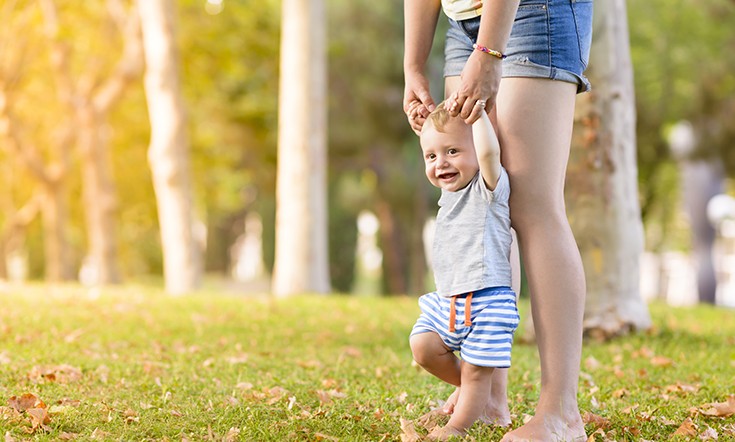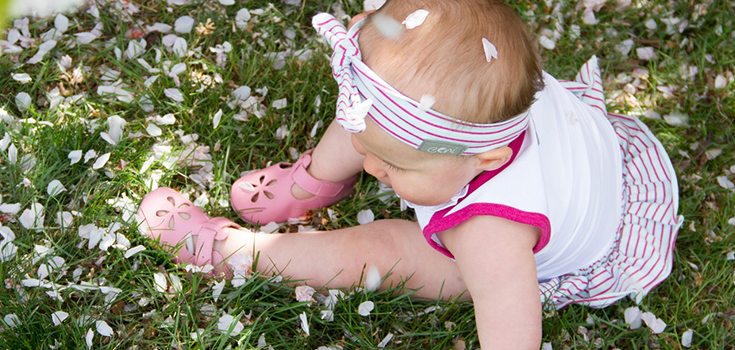

Choosing your baby’s first pair of shoes should be an exciting and fairly simple process…but how and when do you choose the right pair?
This is a question that has baffled parents for years, as we’ve often been lead to believe over many generations, that sturdy with lots of support is best but…
Did you know children’s feet are very different from adults’ – they’re wider across the toes, narrower at the heel and the inner arch is lined with fatty tissue? There are also large gaps between the bones, which are soft like jelly. So, it’s not really surprising that little feet are quite vulnerable.
From new born to around four years old, little feet go through a range of changes. The fatty tissue in the inner arch is exercised away with movement, little bones start to harden and form and muscles learn how to grip the floor. Incredibly though, all 26 bones and 36 joints are not fully formed until 13 years of age!
Because little feet start life so incredibly soft and pliable, they need absolute flexibility to develop as Mother Nature intended. Tight fitting socks, rigid soles and materials that don’t move with wriggles and stretches can hamper healthy development.
As a parent, you are the best person to decide what to put on your child’s feet. We know that there is lots of confusing scientific research out there to support the benefits of going barefoot, but if you have the facts you will understand the importance of choosing the shoes to allow your child’s foot to grow and develop naturally.

(image source @littlehepburn)
Top Common Myths and Facts about Choosing Baby’s First Pair of Shoes:
- Kids feet aren’t like adults – Your baby was born with two feet, ten toes and only the beginning stages of 26 bones. These bones will become strong, hard and supportive so they can hold your child’s body upright for life, but they start out soft, weak and malleable. As your baby goes through those magical stages of sitting up, crawling, cruising, walking and eventually running confidently, their little feet change so dramatically. If cared for correctly their feet will develop naturally, and look after them for life. Unfortunately you can’t make adult shoes and just shrink them down to fit kids – that would damage children’s feet for life.
- Nerves – Feet have over 200,000 nerve endings which is the densest of anywhere in the body. Since 70% of the brain’s information related to movement comes from the nerves in feet, the more your child can feel the ground, the greater their body’s ability to balance and walk correctly. Flexible shoes with thin soles like bobux allow the maximum sensory connection your child needs to develop appropriate sensory perception in their feet.
- Bones – Babies are born with jelly-like bones that harden and form over time. Remember the stories of binding feet in china? This is the most extreme example that shows you just how pliable babies’ feet are. Putting restrictive or poorly fitted shoes onto children basically has the same effect as binding because they shape the foot unnaturally. Feet deformed in this way lead to many problems with feet, ankles, knees, hips and even the spine later in life.
- Muscles – Exercise is critical to ensure strong muscle development. A child needs to exercise their feet through the natural acts of twisting, turning, gripping, flexing and rolling. Allowing feet to be bare provides for this, but for the times they need some extra protection put shoes on their feet that allow natural foot movement.
- Sweat – Yes, kids feet can really smell! Children’s feet sweat twice as much as adults and that is why it is important to allow feet to breathe. Leather breathes which is why it is the best (and least smelly) option for growing feet. Leather is also soft and flexible ensuring feet are not restricted or held unnaturally in place.
- Circulation – Many parents worry their children’s feet might get cold if they don’t wrap them up tightly. The opposite is true. A child who is barefoot or wears flexible footwear has improved circulation and their feet are naturally kept warm.
- Arches – When toes are pressed together from footwear that doesn’t allow toes spread, feet begin to turn outwards to try and get stability. Children then learn to walk uncomfortably using their arches to push off with, instead of their toes. Give your children’s feet a chance. Let them go barefoot or buy the right footwear – shoes that mimic the benefits of bare feet and avoid fallen arches. Soft natural leather with no soles are best.
Trust your instinct – get the facts and then you can decide what is best for your baby.























